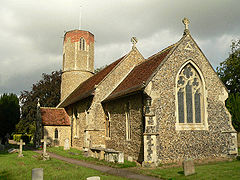Hasketon
| Hasketon | |
|---|---|
 St Andrews Church, Hasketon |
|
| Hasketon shown within Suffolk | |
| Population | 402 (2011) |
| OS grid reference | TM248506 |
| District | |
| Shire county | |
| Region | |
| Country | England |
| Sovereign state | United Kingdom |
| Post town | Woodbridge |
| Postcode district | IP13 2 |
| Dialling code | 01473 |
| Police | Suffolk |
| Fire | Suffolk |
| Ambulance | East of England |
| EU Parliament | East of England |
| UK Parliament | |
Hasketon is a small village in Suffolk, England.
Its church, St. Andrews, is one of 38 existing round-tower churches in Suffolk. St. Andrews stands more or less at the centre of its scattered parish, and is set in a tree-shaded churchyard which, in 1845, had been planted with beech, fir and elm.
There has been a church at this place for more than 900 years. This ancient church contains craftsmanship from many periods. From what can be seen and derived from what little documentary evidence is available, the history of this church is as follows:
The 11th century: The earliest part of the present church is the nave, where evidence of late Saxon or early Norman work in the layered masonry with which parts of the walls are faced can be found. There is also a little herring-bone masonry in the south wall, where there remains a tiny blocked window of this date. Clearly the core of the nave dates from the period just before or just after the Norman Conquest of 1066.
The late 11th or early 12th century: A little later the round tower was added at the west end of the nave.
The 13th century: The single lancet windows in the north walls of the nave and chancel survive from this period.
c.1300: The round tower was heightened by the addition of its octagonal belfry-stage (later restored with brick) and also received its west window. Some similar windows to those in the belfry-stage were placed in the nave and chancel. The 14th and early 15th centuries: Several of the present windows in the nave and the chancel date from this time; they probably replaced earlier windows like the blocked 11th century one. The north and south doorways are also of 14th century date.
...
Wikipedia

